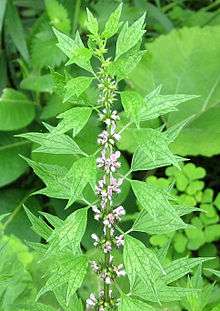Leonurus cardiaca
| Leonurus cardiaca | |
|---|---|
 | |
| Scientific classification | |
| Kingdom: | Plantae |
| (unranked): | Angiosperms |
| (unranked): | Eudicots |
| (unranked): | Asterids |
| Order: | Lamiales |
| Family: | Lamiaceae |
| Genus: | Leonurus |
| Species: | L. cardiaca |
| Binomial name | |
| Leonurus cardiaca | |
Leonurus cardiaca, known as motherwort,[2] is an herbaceous perennial plant in the mint family, Lamiaceae. Other common names include throw-wort, lion's ear, and lion's tail. Lion's tail also being a common name for Leonotis leonurus, and lion's ear, a common name for Leonotis nepetifolia. Originally from Central Asia and southeastern Europe, it is now found worldwide, spread largely due to its use as a herbal remedy.
Description
Leonurus cardiaca has a squarish stem which is clad in short hairs and is often purplish, especially near the nodes. The opposite leaves have serrated margins and are palmately lobed with long petioles; basal leaves are wedge shaped with three points while the upper leaves have five. They are slightly hairy above and greyish beneath. Flowers appear in leaf axils on the upper part of the plant and have three-lobed bracts. The calyx of each flower is bell-shaped and has five lobes. The corolla is irregular, 8 to 12 mm (0.3 to 0.5 in) long, fused, long-tubed with two lips. The upper lip is convex and covered with white hairs and the lower lip is three-lobed and downward-curving and spotted with red. The flowers are pink to lilac in colour often with furry lower lips. There are four stamens, two short and two longer, and the fruit is a four-chambered schizocarp. The plant grows to about 60 to 100 cm (24 to 39 in) in height and blooms during July and August.[3]
Distribution and habitat
Motherwort is probably native to the southeastern part of Europe and central Asia where it has been cultivated since ancient times. Its natural habitat is beside roadsides, in vacant fields, waste ground, rubbish dumps and other disturbed areas. This plant prefers well drained soil and a partly shady location. Introduced to North America as a bee foraging plant and to attract bumble bees, this perennial herb is now considered invasive. It is hardy in USDA climate zones 4–8.[4]
Chemistry

The herb contains the alkaloid leonurine.[5] Among other chemical constituents, it also contains stachydrine,[6] bitter iridoid glycosides (leonuride), diterpinoids, flavonoids (including rutin and quercetin), tannins, volatile oils, and vitamin A.
References
- ↑ Linnæus, Carolus (1753). Species Plantarum. 2. Holmia: Laurentius Salvius. p. 584.
- ↑ "BSBI List 2007". Botanical Society of Britain and Ireland. Archived from the original (xls) on 2015-01-25. Retrieved 2014-10-17.
- ↑ "Motherwort: Leonurus cardiaca". NatureGate. Retrieved 2013-12-14.
- ↑ Leonurus cardiaca L. Common motherwort. NRCS PLANTS database. Retrieved 26 February 2016.
- ↑ Kuhn, Merrily A.; Winston, David; Marderosian, Ara Harold, Der (2000). Herbal therapy supplements: a scientific traditional approach. Philadelphia: Lippincott. p. 232. ISBN 978-0-7817-2643-6.
- ↑ Kuchta, K; Volk, R. B.; Rauwald, H. W. (2013). "Stachydrine in Leonurus cardiaca, Leonurus japonicus, Leonotis leonurus: Detection and quantification by instrumental HPTLC and 1H-qNMR analyses". Die Pharmazie. 68 (7): 534–40. PMID 23923634.
Further reading
- Blanchan, Neltje (2005). Wild Flowers Worth Knowing. Project Gutenberg Literary Archive Foundation.
- Lust, John The Herb Book (1974) New York, New York: Bantam.
- Moore, Michael Medicinal Plants of the Mountain West (1979) Santa Fe, New Mexico: The Museum of New Mexico Press
- Weed, Susun S. Wise Woman Herbal for the Childbearing Year (1986) Woodstock, New York.
External links
